Abstract
Cold acclimation-dependent physiological changes were investigated through photosynthetic activity and some antioxidant enzymes in two winter oilseed rape cultivars (Brassica napus L. ssp. oleifera cvs. Eurol and Hansen) on the basis of leaf age. Chlorophyll fluorescence measurements demonstrated that cold acclimation caused decreased photosynthetic activity in Eurol and Hansen as the leaf age increased. Photosynthetic pigment content declined in both cultivars under low temperature irrespective of leaf age. In Eurol, however, relatively higher total carotenoid content than Hansen may provide a protection against photooxidative damage. Superoxide dismutase, ascorbate peroxidase and glutathione reductase activity in the cold-acclimated leaves of Hansen significantly increased, indicating an effective ascorbate–glutathione cycle activity. In Eurol, however, ascorbate peroxidase and glutathione reductase activity in the cold-acclimated younger leaves lowered and hydrogen peroxide detoxifying system collapsed. As a result, decreased photosynthetic activity in the young leaves of Hansen under low temperature could be manifested as a metabolic response that downregulate photosynthesis to attain cold-acclimated state. In the case of Eurol, cold acclimation process caused oxidative stress. In summary, the changes in the chlorophyll fluorescence parameters in the young leaves of Hansen are derived from some metabolic regulation as a result of cold acclimation, whereas in Eurol, it is due to oxidative stress triggered by low temperature. Leaf maturation mitigated the adverse effects of low temperature in the leaves of Eurol and Hansen.




Similar content being viewed by others
References
Alscher RG, Donahue JL, Cramer CL (1997) Reactive oxygen species and antioxidants: relationships in green cells. Physiol Plant 100:224–233
Asada K (1996) Radical production and scavenging in the chloroplasts. In: Baker NR (ed) Photosynthesis and environment. Kluwer, Dordrecht, pp 123–150
Beyer WF, Fridovich I (1987) Assaying for superoxide dismutase activity: some large consequences of minor changes in conditions. Anal Biochem 161:559–566
Demmig-Adams B, Stewart JJ, Baker CR, Adams WW (2018) Optimization of photosynthetic productivity in contrasting environment by regulons controlling plant form and function. Int J Mol Sci 19:872–893
Foyer CH, Descourvieres P, Kunert KJ (1994) Protection against oxygen radicals: an important defence mechanism studied in transgenic plants. Plant Cell Environ 17:507–523
Georgieva K, Lichtenthaler HL (1999) Photosynthetic activity and acclimation ability of pea plants to low and high temperature treatment as studied by means of chlorophyll fluorescence. J Plant Physiol 155:416–423
Guo YY, Tian SS, Liu SS, Wang WQ, Sui N (2018) Energy dissipation and antioxidant enzyme system protect photosystem II of sweet sorghum under drought stress. Photosynthetica 56:861–872
Habibi G, Vaziri A (2017) High salicylic acid concentration alters the electron flow associated with photosystem II in barley. Acta Agric Slov 109:393–402
Hashimoto H, Uragami C, Cogdell RJ (2016) Carotenoids and photosynthesis. In: Stange C (ed) Carotenoids in nature. Subcellular biochemistry. Springer, Cham, pp 111–139
Huner NPA, Öqüist G, Sahran F (1998) Energy balance and acclimation to light and cold. Tr Plant Sci 3:224–230
Hurry VM, Strand A, Tobiaeson M, Gardeström P, Öqüist G (1995) Cold hardening of spring and winter wheat and oilseed rape results in differential effects of on growth, carbon metabolism, and carbohydrate content. Plant Physiol 109:697–706
Jahns P, Holzwarth AR (2012) The role of the xanthophyll cycle and of lutein in photoprotection of photosystem II. Biochim Biophys Acta-Bioenerg 1817:182–193
Karpinski S, Reynolds H, Karpinska B, Wingsle G, Creissen G et al (1999) Systemic signalling and acclimation in response to excess excitation energy in Arabidopsis. Science 284:654–657
Li XG, Meng QW, Jiang GQ, Zou Q (2003) The susceptibility of cucumber and sweet pepper to chilling under low irradiance is related to energy dissipation and water-water cycle. Photosynthetica 41:259–265
Lichtenthaler HK (1987) Chlorophylls and carotenoids: pigments of photosynthetic membranes. Met Enzymol 148:350–382
Maxwell K, Johnson GN (2000) Chlorophyll fluorescence-a practical guide. J Exp Bot 51:659–668
Meravi N, Prajapati SK (2018) Temporal variation in chlorophyll fluorescence of different tree species. Biol Rhythm Res 49:1–7
Mutlu S, Atıcı Ö, Nalbantoğlu B, Mete E (2016) Exogenous salicylic acid alleviates cold damage by regulating antioxidative system in two barley (Hordeum vulgare L.) cultivars. Front Life Sci 9:99–109
Pitcher LH, Brennan E, Hurley A, Dunsmuir P, Tepperman JM, Zilinskas BA (1991) Overproduction of petunia chloroplastic copper/zinc superoxide dismutase does not confer ozone tolerance in transgenic tobacco. Plant Physiol 97:452–455
Plazek A, Rapacz M, Hura K (2004) Relationship between quantum efficiency of PSII and cold-induced plant resistance to fungal pathogens. Acta Physiol Plant 26:141–148
Rapacz M (1999) Frost resistance and cold acclimation abilities of spring-type oilseed rape. Plant Sci 147:55–64
Rapacz M (2002) Regulation of frost resistance during cold de-acclimation and re-acclimation in oilseed rape. A possible role of PSII redox state. Physiol Plant 115:236–243
Rapacz M, Hura K (2002) The pattern of changes in photosynthetic apparatus in response to cold acclimation and de-acclimation in two contrasting cultivars of oilseed rape. Photosynthetica 40:63–69
Rorat T, Havaux M, Irzykowski W, Cuine S, Becuwe N et al (2001) PSIIS gene expression, photosynthetic activity and abundance of plastid thioredoxin-related and lipid-associated proteins during chilling stress in Solanum species differing in freezing resistance. Physiol Plant 113:72–78
Ruban AV (2016) Nonphotochemical chlorophyll fluorescence quenching: mechanism and effectiveness in protecting plant from photodamage. Plant Physiol 170:1903–1916
Schreiber U, Schliw U, Bilger W (1986) Continuous recording of photochemical and non- photochemical fluorescence quenching with a new type of modulation fluorometer. Photosynth Res 10:51–62
Schreiber U, Bilger W, Neubauer C (1994) Chlorophyll fluorescence as a nonintrusive indicator for rapid assessment of in vivo photosynthesis. In: Schulze ED, Caldwell MM (eds) Ecological studies, vol 110. Ecophysiology of photosynthesis. Springer, Berlin, pp 49–70
Sgherri CLM, Loggini B, Puliga S, Navari-Izzo F (1994) Antioxidant system in Sporobolus stapfianus: changes in response to desiccation and rehydration. Phytochemistry 35:561–565
Strand A, Hurry V, Gustafsson P, Gardeström P (1997) Development of Arabidopsis thaliana leaves at low temperatures releases the suppression of photosynthesis and photosynthetic gene expression despite the accumulation of soluble carbohydrates. Plant J 12:605–614
Thomas H, Ougham H, Hörtensteiner S (2001) Recent advances in the cell biology of chlorophyll catabolism. Adv Bot Res 35:1–52
Wang SY, Jiao H, Faust M (1991) Changes in ascorbate, glutathione and related enzyme activity during thidiazuron-induced bud break of apple. Plant Physiol 82:231–236
Wang L, Yao L, Hao X, Li N, Wang Y et al (2019) Transcriptional and physiological analysis reveal the association of ROS metabolism with cold tolerance in tea plants. Environ Exp Bot 160:45–58
Wani MA, Qazi HA, Yaqoob U, Lone SA, John R (2017) Response of radish genotypes to short term cold stress in relation to biochemical changes and antioxidant activity. Int J Curr Agric Sci 7:222–228
Xin Z, Browse J (2000) Cold comfort farm: the acclimation of plants to freezing temperature. Plant Cell Environ 23:893–902
Yoon YE, Kuppusamy S, Cho KM, Kim PJ, Kwack YB, Lee YB (2017) Influence of cold stress on contents of soluble sugars, vitamin C and free amino acids including gamma- aminobutyric acid (GABA) in spinach (Spinacia oleracea). Food Chem 215:185–192
Acknowledgements
This study was funded by Hacettepe University Scientific Research Fund (Grant Number: 0201601005).
Author information
Authors and Affiliations
Contributions
All authors contributed to the study conception and design. Material preparation, data collection and analysis were performed by AD. The first draft of the manuscript was written by AD, and all authors commented on previous versions of the manuscript. All authors read and approved the final manuscript.
Corresponding author
Additional information
Publisher's Note
Springer Nature remains neutral with regard to jurisdictional claims in published maps and institutional affiliations.
Rights and permissions
About this article
Cite this article
Doğru, A., Çakirlar, H. Effects of leaf age on chlorophyll fluorescence and antioxidant enzymes activity in winter rapeseed leaves under cold acclimation conditions. Braz. J. Bot 43, 11–20 (2020). https://doi.org/10.1007/s40415-020-00577-9
Received:
Revised:
Accepted:
Published:
Issue Date:
DOI: https://doi.org/10.1007/s40415-020-00577-9




